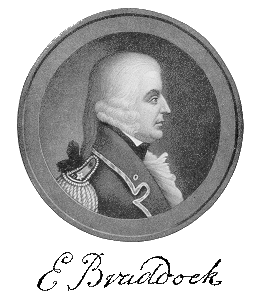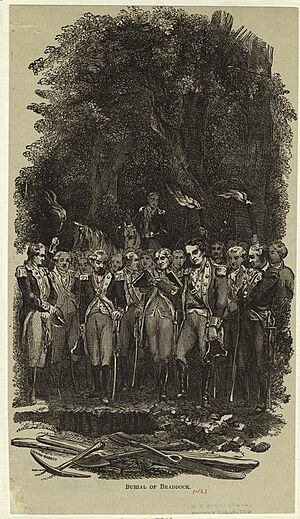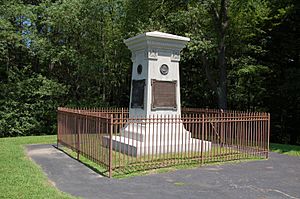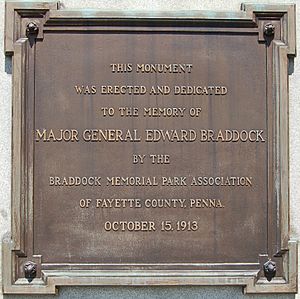Edward Braddock facts for kids
Quick facts for kids
Edward Braddock
|
|
|---|---|

General Edward Braddock (note: the accuracy of this portrait has been widely challenged; no image of Braddock prior to his death has ever been found or is known to exist)
|
|
| Born | January 1695 London, England |
| Died | 13 July 1755 (aged 60) Great Meadows, North America (present-day Farmington, Pennsylvania) |
| Buried | |
| Allegiance | |
| Service/ |
|
| Years of service | 1710–1755 |
| Rank | Major-General |
| Unit | Coldstream Guards |
| Commands held | Expedition to Fort Duquesne |
| Battles/wars | |
Edward Braddock was a British army officer. He was born in January 1695 and died on July 13, 1755. He became the main commander for the British colonies in North America. This was at the start of the French and Indian War. This war was part of a bigger conflict called the Seven Years' War in Europe. Braddock is mostly known for leading a very difficult journey. This journey was against the French in the Ohio River Valley in 1755. It was during this expedition that he died.
Contents
Becoming a Soldier
Edward Braddock followed his father into the British army. His father was also a Major-General in the Coldstream Guards. Edward joined the same regiment when he was 15 years old. This was on October 11, 1710.
He slowly moved up in rank over the years. He became a lieutenant in 1716. By 1736, at age 41, he was promoted to captain. In 1743, he became a major. Two years later, in 1745, he was made lieutenant-colonel.
Braddock took part in the Siege of Bergen op Zoom in 1747. This was a battle during the War of the Austrian Succession. In 1753, he became a full colonel. The next year, he was promoted to major-general.
Leading Troops in North America
In 1755, Braddock was chosen to lead British forces in North America. His mission was to fight against the French. He arrived in Hampton, Virginia, on February 20, 1755.
He met with several colonial governors in April. They planned strong attacks against the French. The British planned to attack in four different places. Braddock himself would lead a journey against Fort Duquesne. This fort was located where Pittsburgh is today.
The March to Fort Duquesne
Braddock spent months getting ready for his journey. It was hard because he didn't get all the supplies he was promised. Finally, his expedition began. A young George Washington joined him as a volunteer officer.
Braddock took a smaller group of his best soldiers. He marched them ahead, leaving most of his men behind. On July 9, 1755, his column crossed the Monongahela River. Soon after, they ran into French and Native American forces. These forces were rushing from Fort Duquesne to stop them.
The Battle of the Monongahela
At first, the British seemed to be winning the fight. The French commander was shot, and some Canadian soldiers ran away. But the Native American and French forces quickly regrouped. They moved to the sides of Braddock's column. Then they began firing from many directions.
Braddock's soldiers became confused and disorganized. The British tried to retreat. But they ran into the rest of their soldiers who had been left behind. Braddock tried to rally his men many times. But he was finally shot through the chest and badly wounded.
People still debate why the British lost this battle. One reason might be that Braddock didn't realize how well the French and Native Americans could fight. He also didn't expect his own soldiers to lose their discipline so quickly.
Braddock's Death and Burial
Braddock was carried off the battlefield by George Washington and Colonel Nicholas Meriwether. He died on July 13 from his wounds. Before he died, Braddock gave Washington his special sash and two pistols. Some of his last words were, "Who would have thought?" and "we shall know better another time."
Washington reportedly kept this sash with him for the rest of his life. He wore it as commander of the Continental Army and later as president. You can still see it today at Washington's home, Mount Vernon.
Braddock was buried west of Great Meadows. This is where the remaining soldiers stopped their retreat. He was buried in the middle of the road his men had just built. Wagons were then rolled over his grave. This was done to hide his body from Native Americans. George Washington led the burial service.
Braddock's Legacy
Benjamin Franklin wrote about helping General Braddock get supplies. This was for Braddock's troops. Franklin also said he warned Braddock about marching through a narrow valley. He thought it could be dangerous due to ambushes. However, the actual battle was not in a narrow valley. Braddock had taken steps to avoid ambushes.
In 1804, workers building a road found human remains. They were believed to be Braddock's. This was about 1.5 miles (2.4 km) west of Great Meadows. The remains were moved and reburied nearby. A marble monument was placed over the new grave in 1913.
Many places are named after General Braddock. These include Braddock Borough, Mt. Braddock, Braddock Hills, and North Braddock in Pennsylvania. There is also Braddock Heights in Maryland. Roads like Braddock Road in Virginia are also named for him. Parts of the road his army built are still known as the Braddock Road today.
Braddock in Stories
Braddock appears as a character in the video game Assassin's Creed III. In the game, George Washington is a young officer serving under Braddock. The game shows Braddock as a harsh general. He kills enemies, civilians, and even his own allies. He is also a former member of a group called the Templar Order. He is a rival of Haytham Kenway, another character in the game. During his 1755 journey, Braddock is killed by Haytham. This happens with the help of Native American tribes. They wanted Braddock gone because his men hurt their villages.
Robert Matzen made a documentary film called When the Forest Ran Red. It shows the ambush of Braddock's army. This ambush was by French soldiers and Native Americans.
See also
 In Spanish: Edward Braddock para niños
In Spanish: Edward Braddock para niños




